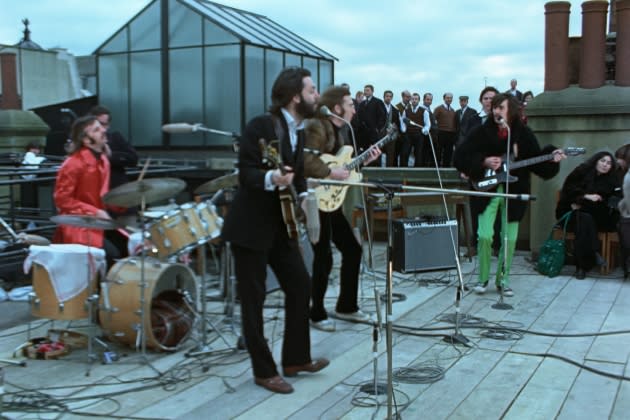The Secret History of the Beatles’ ‘Let It Be’
- Oops!Something went wrong.Please try again later.
- Oops!Something went wrong.Please try again later.

Producer/engineer Glyn Johns recorded the whole of the Let It Be sessions for the Beatles in 1969, and mixed a raw version of the album that wouldn’t be released for another 52 years — so he’s far from a fan of the Phil Spector-embellished album that came out in 1970. “He did a terrible job,” Johns says on the new episode of Rolling Stone Music Now. “Don’t misunderstand me — I respect Phil Spector for his early work tremendously. But somebody like Phil Spector shouldn’t ever be allowed near a band like the Beatles, in my view. Phil Spector was always the artist in the records that he made. He treated the artists like parts of the machine to make the end result. I don’t think the Beatles ever require that kind of input.”
More from Rolling Stone
Ringo Starr: The Beatles Would 'Never' Fake John Lennon's Voice with AI
Lace Me Up: Skechers Drops New Limited-Edition The Rolling Stones Sneaker Collection
Paul McCartney Used AI to Make a Final Beatles Song - But Not in a Creepy Way
The new episode, which also includes an interview with Ringo Starr, was recorded live at the Rock and Roll Hall of Fame on Starr’s 83rd birthday, with Rob Sheffield and Hall of Fame vice president of education Jason Hanley joining host Brian Hiatt to interview Johns about the making of Let It Be and more. To hear the whole episode — which also includes some of Johns’ memories of working with The Rolling Stones, the Who, and Led Zeppelin — go here to the podcast provider of your choice, listen on Apple Podcasts or Spotify, or just press play above. A few highlights follow:
Johns thinks the Beatles improved tremendously as players from their early days. “I had the good fortune to be present on a recording for a TV show they did in the very early sixties called Around the Beatles, and it was done at the studio where I was working,” Johns says. “And the backing tracks sounded pretty average, like any band really. I actually think they all developed tremendously as musicians from there, George in particular. George was not the most instinctive guitar player like Eric [Clapton] George needs time to sit and work stuff out, and when he does it is phenomenal. It’s just phenomenal. Ringo, I didn’t pay much attention to initially, but by the time I got to record them, it became apparent to me what an astonishing drummer he is, and I don’t think he gets nearly enough credit to this day. He really is quite remarkable. His feel. I’m talking about his feel. His technical ability is average, but his feel exceptional. Also, what he does, where he puts what he plays is quite remarkable. And without him, they would not have been the same band. I don’t care what anybody says.”
Starr has no idea where he got the beat he plays on the released version of “Get Back.”
In early rehearsals, as shown in Peter Jackson’s Get Back documentary, “it’s just straight rock,” Starr says. “And then it’s on the roof and I’m, I’ve got that shuffle-swing march going and I don’t know what came into me to do that. I just felt good at the time doing that. That’s how most of my drumming was actually. It’s a feeling kind of playing, not an absolute restrictive type of drumming.”
When George Harrison temporarily left the Beatles during the making of Let It Be, it felt “very real,” Johns says. “Extremely real! He even took his eight track back. Talk about throwing your toys out the pram! I was really upset: ‘Bloody hell. I’ve waited all these years to work with them. I’ve been in it for two minutes, and it looks like it’s all over already.’ And of course, that turned out not to be the case, but it was pretty disappointing.”
With the notable exception of Harrison’s departure, there were few signs that the Beatles were nearly done as a band during the sessions. “It never entered my mind that they’d break up,” says Johns. “Obviously George leaving when he did was an awkward moment. But I think if George had have stayed gone, they’d have got another guitar player.”
Members of the Stones and the Beatles took an instant dislike to Led Zeppelin. “When Zeppelin set up and started to play, I was literally pinned to the back wall by what I heard,” says Johns, who engineered Led Zeppelin I the same year as the Let It Be sessions. “It was nothing like what I expected. But I remember taking the record and playing it to George Harrison on the way home from a Beatles session, and he didn’t like it at all. And I remember playing it to Mick Jagger, because I thought they should go on the Rock and Roll Circus [TV special]. And Mick didn’t like it at all either!”
Download and subscribe to Rolling Stone’s weekly podcast, Rolling Stone Music Now, hosted by Brian Hiatt, on Apple Podcasts or Spotify (or wherever you get your podcasts). Check out six years’ worth of episodes in the archive, including in-depth, career-spanning interviews with Bruce Springsteen, Mariah Carey, Halsey, Neil Young, Snoop Dogg, Brandi Carlile, Phoebe Bridgers, Rick Ross, Alicia Keys, The National, Ice Cube, Taylor Hawkins, Willow, Keith Richards, Robert Plant, Dua Lipa, Questlove, Killer Mike, Julian Casablancas, Sheryl Crow, Johnny Marr, Scott Weiland, Liam Gallagher, Alice Cooper, Fleetwood Mac, Elvis Costello, John Legend, Donald Fagen, Charlie Puth, Phil Collins, Justin Townes Earle, Stephen Malkmus, Sebastian Bach, Tom Petty, Eddie Van Halen, Kelly Clarkson, Pete Townshend, Bob Seger, the Zombies, and Gary Clark Jr. And look for dozens of episodes featuring genre-spanning discussions, debates, and explainers with Rolling Stone’s critics and reporters.
Best of Rolling Stone
